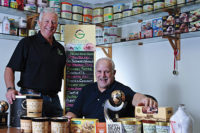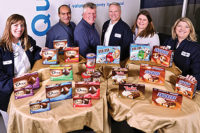The onsite lab does microbiological testing on daily batches. Deliveries are inspected and recorded by the shipping department. Incoming and outgoing loads and less-than-truckload (LTL) shipments are sealed and locked upon arrival or departure.
With demand growing for the Gifford’s brand, as well as private-label accounts, the processor is looking to expand the size of the building to increase production space. It is adding a raw C.I.P. tank and taking out the raw C.O.P. tank.
Ergonomics and safety
“We still consider ourselves a small company and we take employee safety very seriously,” Roger Gifford said. Staff provides yearly safety training for production employees, and that is complemented by training from an outside vendor. Safety programs range from chemical awareness to proper lifting techniques.
Gifford’s uses a monthly self-auditing system, which covers everything from the grounds to good manufacturing practices. Its list of approved suppliers is made up of companies that have been required to show proof of a food safety system as well as a current third-party audit. Randolph Associates performs a third-party audit at Gifford’s.
“Being a small company, our employees may take just a little more pride in the product they produce every day,” John said. “That gives Gifford’s and the employees here the ability to really buy into a food safety plan.”
Gifford’s makes ice cream in a building that dates to the Roaring ‘20s and in freezers that date to World War II. The brothers are proud of the old-fashioned techniques they use. But they have looked to the future by upgrading equipment and planning for increased production. New customers will mean more ice cream. A new generation of Giffords is moving into management positions. This generation will take the company’s “ famous ice cream” to new locations, far from the company’s roots in a little processing plant on Hathaway Street in a little town in central Maine. N
Gifford's At A Glance
Gifford’s, Skowhegan, Maine
Age of plant: The building dates to the 1920s when it was a milk receiving station.
Size: 29,067 square feet
Number of production employees: Nine full-time, two seasonal
Products made: Frozen yogurt, sherbet, sorbet, ice cream
Total processing capacity (annually): 3 million gallons
Number of shifts: 1
Storage silos: 8 storage silos. Five 2,000 gallon, one 3,000 gallon, one 5, 000 gallon, one 10,000 gallon
Pasteurization: High Temperature/Short Time, 1,200 gallons per hour
Number of filling lines: Two filling lines, one for bulk cans and the second one half-gallons, quarts and 56-ounce containers
Warehouse: 4,323 square feet, two bays
Storage capacity: Raw milk, 15,000 gallons; pasteurized 18,000 gallons







